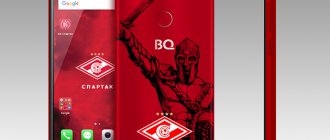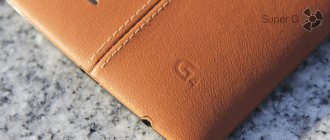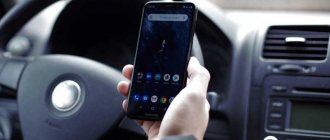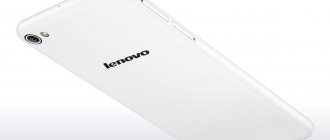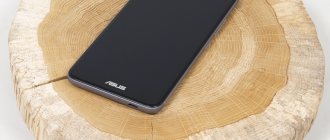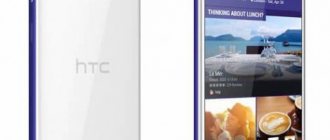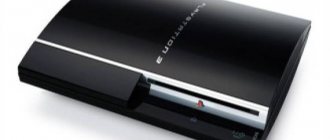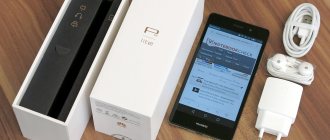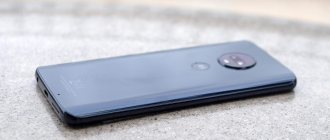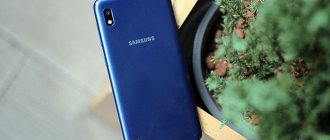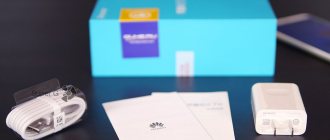Many first-tier manufacturers continue to produce “mini” smartphones that look similar to the current flagship gadget. But only externally: apart from the recognizable exterior, they have nothing special to brag about. Such devices are sold primarily due to the big names of their older brothers. The unlucky buyer thinks: “My smartphone is almost like substituting the name of the flagship of some Korean or Taiwanese company, only cheaper and a little smaller.” Well, in fact, the next Mini, in terms of its characteristics, turns out to be more like a budget gadget, while manufacturers do not hesitate to charge extra money for a big name. An exception to this rule is the Sony Xperia Compact series smartphones: they only have reduced body dimensions, and the technical filling is comparable to the hardware of the corresponding flagship model. True, they cost almost the same.
LG also often uses the name of the flagship in the names of simpler models and also charges money for this, but this manufacturer has a much wider range of such devices, and it includes quite decent options - for example, LG G3s. The name, frankly, is not the best: the letter s most often indicates that the device (or car - this also often happens to them) has become faster, more powerful and simply better than the original model. However, this is definitely not about the G3s. The technical content of the device is quite modest: a display with HD resolution, a Qualcomm Snapdragon 400 system-on-chip, an 8-megapixel camera. But the device received not only a recognizable name and design, but also some of the “tricks” of the flagship LG G3, for example, a very convenient proprietary software shell and laser autofocus.
⇡#Technical characteristics
| LG G2 (D802) | LG G3 (D855) | LG G3s LTE (D722) | |
| Display | 5.2 inches, 1920 × 1080, IPS | 5.46 inches, 2560 × 1440, IPS | 5 inches, 1280 × 720, IPS |
| Touch screen | Capacitive, up to 10 simultaneous touches | Capacitive, up to 10 simultaneous touches | Capacitive, up to 5 simultaneous touches |
| Air gap | No | No | Eat |
| Oleophobic coating | Eat | Eat | No |
| Polarizing filter | Eat | Eat | No |
| Protective glass | Corning Gorilla Glass 3 | Corning Gorilla Glass 3 | Corning Gorilla Glass 3 |
| CPU | Qualcomm Snapdragon 800 MSM8974AA v2: four Qualcomm Krait-400 cores (ARMv7); frequency 2.27 GHz; process technology 28 nm HPm | Qualcomm Snapdragon 801 MSM8974AC v3: four Qualcomm Krait-400 cores (ARMv7); frequency 2.5 GHz; process technology 28 nm HPm | Qualcomm Snapdragon 400 MSM8926: four ARM Cortex-A7 cores (ARMv7); frequency 1.2 GHz; 28 nm process technology |
| Graphics controller | Qualcomm Adreno 330, 450 MHz | Qualcomm Adreno 330, 578 MHz | Qualcomm Adreno 305, 450 MHz |
| RAM | 2 GB | 2 GB | 1 GB |
| Flash memory | 16 or 32 GB | 16 (about 11 GB available) or 32 GB + microSD | 8 GB (approx. 4.7 GB available) + microSD |
| Connectors | 1 × micro-USB 2.0 (SlimPort) 1 × 3.5 mm headset jack 1 × micro-SIM | 1 × micro-USB 2.0 (SlimPort) 1 × 3.5 mm headset jack 1 × micro-SIM 1 × microSD | 1 × micro-USB 2.0 1 × 3.5 mm headset jack 1 × micro-SIM 1 × microSD |
| cellular | 2G: GSM/GPRS/EDGE 850/900/1800/1900 MHz 3G: DC-HSPA+ (84 Mbps) 850/900/1900/2100 MHz 4G: LTE Cat. 4 (150 Mbit/s) band 1, 3, 7, 8, 20 (2100/1800/2600/900/800 MHz) One micro-SIM card | 2G: GSM/GPRS/EDGE 850/900/1800/1900 MHz 3G: HSDPA (42 Mbps) 850/900/1900/2100 MHz 4G: LTE Cat. 4 (150 Mbit/s) band 3, 7, 20 (1800/2600/800 MHz) One micro-SIM SIM card | 2G: GSM/GPRS/EDGE 850/900/1800/1900 MHz 3G: HSDPA+ (21 Mbps) 900/2100 MHz 4G: LTE Cat. 4 (150 Mbit/s) band 1, 3, 7, 8, 20 (2100/1800/2600/900/800 MHz) One micro-SIM card |
| WiFi | 802.11a/b/g/n/ac, 2.4/5 GHz | 802.11a/b/g/n/ac, 2.4/5 GHz | 802.11b/g/n, 2.4 GHz |
| Bluetooth | 4.0 | 4.0 | 4.0 |
| NFC | Eat | Eat | Eat |
| IR port | Eat | Eat | Eat |
| Navigation | GPS, A-GPS, GLONASS | GPS, A-GPS, GLONASS | GPS, A-GPS, GLONASS |
| Sensors | Light sensor, proximity sensor, accelerometer/gyroscope, Hall sensor (digital compass) | Light sensor, proximity sensor, accelerometer/gyroscope, Hall sensor (digital compass) | Light sensor, proximity sensor, accelerometer/gyroscope, Hall sensor (digital compass) |
| Main camera | 13 MP (4160 × 3120), Sony Exmor RS matrix with back illumination; Multi-point autofocus, single-axis optical image stabilization, LED flash | 13 MP (4160 × 3120), Sony Exmor RS matrix with back illumination; Laser autofocus, dual-axis optical image stabilization, dual-LED flash | 8 MP (3264 × 2448), Sony Exmor R matrix with back illumination; Laser autofocus, LED flash |
| Front-camera | 2.1 MP (1920 × 1080) Pixel size 1.12 µm No autofocus, no flash | 2.1 MP (1920 × 1080) 1.4 µm pixel size No autofocus, no flash | 1.3 MP (1280 × 960) No autofocus, no flash |
| Nutrition | Non-removable battery 11.4 Wh (3000 mAh, 3.8 V) | Removable battery 11.4 Wh (3000 mAh, 3.8 V) | Removable battery 9.65 Wh (2540 mAh, 3.8 V) |
| Size | 139 × 71 mm Case thickness 9.5 mm | 146 × 74.5 mm Case thickness 8.9 mm | 138 × 70 mm Case thickness 10.3 mm |
| Weight | 143 g | 149 g | 134 g |
| Water and dust protection | No | No | No |
| operating system | Google Android 4.2.2 (Jelly Bean) | Google Android 4.4.2 (KitKat) | Google Android 4.4.2 (KitKat) |
| Current price | About 16 thousand rubles | About 30 thousand rubles | About 13 thousand rubles |
| LG G3s LTE – information about the system and hardware according to the application | ||
Description of the advantages and disadvantages of the G3 S phone
The dimensions of the LG G3 S are 69.6 mm wide, 137.7 mm long and 10.3 mm thick. With such dimensions it is convenient to operate the device with one hand. In addition, the weight of the device is about 137 g. Even if you operate the device with one hand, its weight is almost not felt.
If we evaluate the overall ease of use of the phone taking into account the size and weight, then there will be no problems with everyday use.
The smartphone is equipped with a 4-core Qualcomm Snapdragon 400 MSM8926 processor, which is made at 28 nm. technical process.
The smartphone has only 1 GB. RAM, which is quite small. Instances of low RAM will occur regularly, so even when using light applications you will experience instability in operation.
The storage capacity of the device is 8 GB, and if the smartphone is mainly used for correspondence and social networks, then there will be no problems, but if you are going to use it for photography, video shooting and games, you should look at a device of a higher class.
The phone is compatible with SD cards, so you can easily expand its memory. So you probably don't need to worry about storage capacity.
The G3 S has a 5-inch display diagonal. The display is large enough that you will rarely have problems with its size. However, this display is not suitable for writing long texts.
The smartphone has a high-end display and any graphic content you display on it, including videos and games, will be displayed clearly.
The main camera of the phone has 7.99 megapixels, which should be enough in most cases. However, you may be slightly unsatisfied with the quality of the photos.
Also, the smartphone has a front camera of 0.92 megapixels, which is low. If you care about the quality of your photos, you should consider a higher-end smartphone.
The battery capacity of the LG G3 S is 2540 mAh, which is a typical capacity indicator. Compared to other smartphones, the battery life of the LG G3 S is average. You don't have to worry about anything during daily use. However, if you spend time surfing the internet or playing games, you might be a little underwhelmed by the battery life.
⇡#Appearance and ergonomics
Briefly about the appearance of the LG G3s: the same smartphone as the LG G3, only a little smaller. Indeed, the difference in dimensions is by no means as significant as it could be. The G3s display is only half an inch smaller than the G3 screen, the frames, on the contrary, are wider - accordingly, the dimensions of the devices are similar. The engineers managed to save literally a few millimeters in length and width. Nevertheless, the device is quite comfortable to use with one hand - the thumb can easily reach all four corners of the display. There is no need to hold the device and place it in your palms.
LG G3s LTE – front panel
The thickness of the case is quite large - 10.3 millimeters. However, the G3s doesn't look "chubby" at all. Its back back is rounded on the sides. This makes the device appear thinner than it actually is. A very winning visual illusion. The device weighs moderately – 134 grams. From time immemorial and to this day, iPhone owners consider such a mass to be ideal - not heavy, and not too airy and incorporeal.
LG G3s LTE with screen on
There are no hard keys on the front panel - LG prefers on-screen buttons. At the top of the panel there is an LED indicator, a front lens, a 1.3-megapixel camera, a speaker and a proximity sensor.
LG G3s LTE with screen on
The power and volume control keys are located on the rear panel. This arrangement of buttons may seem strange to those who are not familiar with LG G series smartphones, but Koreans have been using it for several years now - it is quite successful. It is convenient to press the keys with your index finger, no matter in which hand the smartphone is held. True, it is still better to place the device in your pocket with the display facing you to avoid accidental pressing of physical keys. You should also remember that the smartphone can also be unlocked by double tapping on the screen - in this case there is no need to press a hardware key (this is called KnockOn, and there is also a combination of tapping on different parts of the screen called Knock Code). Above the button block is the peephole of the main eight-megapixel camera with a single LED flash and a laser focus sensor.
LG G3s LTE – rear panel
The back panel of the device is removable, and it is made of fairly thin plastic and bends like a real acrobat. The cover fits tightly to the smartphone body - there are no backlashes or gaps, and it is not prone to breakage.
LG G3s LTE – plastic back cover
Under the “back” of the device there is a removable lithium-ion battery of 9.65 Wh (2540 mAh, 3.8 V) - significantly less than that of the LG G3. If necessary, replacing the battery is not difficult. At the top, one above the other, there are slots for Micro-SIM and microSD cards.
LG G3s LTE with back cover removed
At the top end of the case there is an infrared port designed to control household appliances - usually simpler models are deprived of this option, but in the G3s, fortunately, it remains. The Micro-USB interface and a universal 3.5 mm audio jack are located at the bottom. The sides of the device are empty.
LG G3s LTE – side ends
The device is assembled well. When the sides are compressed, no colored streaks appear on the matrix - there are enough stiffening ribs in the structure. True, the plastic creaks a little, but this is quite normal. The appearance of the LG G3s, subjectively speaking, is very pleasant - among devices in the mid-price category, such nice gadgets are rare.
LG G3 S: alternative
You can get the Samsung Galaxy S4 Mini by paying about 1,000 rubles less. This smartphone has an extremely clear 4.3-inch OLED display, a powerful 1.7 GHz dual-core processor, 8 GB of built-in (expandable) memory, an LTE module and a good 8-megapixel camera. The S4 Mini is an overall better and more compact smartphone than its LG competitor.
| TEST RESULTS | |
| Battery (15%) 71 % | |
| Equipment (20%) 69.2 % | |
| Display (15%) 81.3 % | |
| Camera (10%) 59.4 % | |
| Productivity and Management (30%) 82.2 % | |
| Telephony and sound (10%) 77.5 % | |
| CONCLUSION During the test, the LG G3 S proved to be a solid smartphone with long battery life and a fast LTE module. Unfortunately, it has too little built-in memory, and the camera is too weak. In addition, the display could be a little brighter. | 75% OVERALL RESULT |
⇡#Display
The smartphone has a five-inch display with HD resolution (1280 × 720 pixels). The pixel density is moderate at 294 ppi. On the one hand, this value is very close to the psychological barrier of 300 ppi, after which, as is commonly believed, individual points are not visible to the human eye. On the other hand, the screen on the G3s is still grainy, especially compared to the fantastically sharp screen on the G3, and there’s nothing you can do about it. It’s easy to see individual dots on the display – just bring the device closer to your eyes. Small fonts “float” a little – you can, of course, read from the LG G3s screen, but it’s not very comfortable. Multimedia content, on the contrary, looks moderately sharp - not Quad HD, but I don’t want to swear. Probably, for a device at the level of the LG G3s, this is the optimal resolution - less, of course, is not necessary, but the weak system-on-chip will not be able to cope with more.
The device uses an IPS type matrix. True, it’s not the best: if you look away from the perpendicular, the picture noticeably loses contrast. So much so that the black color becomes dark grey. Because of this, say, watching videos on a smartphone together is not very convenient. But the screen is very responsive: the device quickly and accurately responds to touches and recognizes gestures without problems. The gadget supports only up to five simultaneous touches – this is enough for comfortable work, but is a sign of the “budget” origin of the display. But the smartphone understands touches with loose gloves.
LG G3s LTE – AnTuTu MultiTouch Test results
Further - sadder. Firstly, there is an air gap between the protective glass and the matrix itself, which is why the screen glares in bright light. Secondly, the display fades mercilessly in the sun - it does not have a polarizing filter. And thirdly, to the touch the surface of the front panel resembles window glass - there is no oleophobic coating here either, so the glass turns out to be quite easily soiled, it quickly collects fingerprints, and getting rid of them is not so easy. Perhaps everything except what is described in this paragraph is rather good in the screen, but there are also plenty of shortcomings - such displays usually go to very budget devices.
But the screen’s brightness reserve is quite high: the maximum luminosity of the white field is 422 cd/m2, the minimum is 17 cd/m2, that is, in the dark the device is very gentle on the eyes. Unfortunately, the high brightness margin is not able to compensate for the abundance of glare. For indoor use, the brightness is enough for the eyes, but outdoors the screen can glare so much that the information on it will be unreadable. The G3s does not have automatic brightness adjustment, because there is no corresponding sensor; the backlight level will have to be adjusted manually. It’s also unusual - this option is most often found in smartphones for this kind of money.
The luminosity of the black field at the maximum display backlight level is moderate - 0.43 cd/m2. Blacks only lose a little depth at maximum brightness. It turns out that the screen of the G3s is quite contrasty, especially by the standards of devices in the mid-price category: its contrast value is 981:1.
The grayscale color temperature of the LG G3s screen exceeds the reference value of 6500 K - it averages 8200 K, and, which is not very great, it is not uniform - darker shades turn out to be cooler. And in general, the deviation is quite large - the colors on the smartphone display are cold, and this is noticeable to the naked eye. Unfortunately, software adjustment of white balance is not provided here.
The screen is not calibrated very well. All gamma curves have a noticeable bend along their entire length relative to the reference curve. This means that both intermediate shades of primary colors and shades of gray on the G3s screen do not look bright enough - the picture is somewhat underlit. This is not to say that the deviation is critical - to the eye the image looks quite tolerable. However, those who work with color should take this into account.
LG G3s LTE - smartphone screen color gamut (yellow triangle) compared to sRGB reference space (white triangle)
But the color gamut of the display almost completely coincides with the sRGB color space - this is great, neither add nor take away. The colors on the display are displayed as saturated as the content authors intended - most existing images are adapted specifically to the sRGB standard.
⇡#Hardware and performance
The smartphone is equipped with a well-known and already tired system-on-a-chip – Qualcomm Snapdragon 400 MSM8926. This is perhaps the most popular solution for mid-priced devices from first-tier manufacturers. The problem is that it is already quite old - this platform turned two years old in February. This is a very long time for the mobile device industry. Accordingly, one cannot count on a high level of performance, especially since the 400th Snapdragon was initially positioned as a middle-end solution. Let us remind you, in case anyone has forgotten: this platform includes four 32-bit ARM Cortex-A7 cores operating at a frequency of 1.2 GHz and Adreno 305 graphics. The chip is made using a 28-nm process technology.
In the general synthetic test AnTuTu Benchmark 5, which checks all the main “nodes” of the gadget, the LG G3s LTE scored less than eighteen thousand points. By modern standards, this is not a lot at all, or even just a little. The result, by the way, is very strange. For example, ZTE Star 1, running on a similar system-on-a-chip, but equipped with a display with Full HD resolution (and not just HD), scored more - 21 thousand “parrots”. Why this is so is unclear. Probably, the proprietary LG shell takes away too many computing resources from the G3s, which in this case are worth their weight in gold. We will regard this as another reminder that the use of a particular system-on-a-chip in combination with a screen of a certain resolution does not make it possible to accurately predict the performance of the device.
However, during everyday use, the device tries by hook or by crook not to slow down and render the picture smoothly. In general, the Snapdragon 400 is quite capable of “pumping up” an HD screen without slowdowns – we have seen this more than once while testing various budget smartphones and tablets. True, with the G3s the picture is no-no, and it jerks out of the blue. The small amount of RAM can have an effect - the device has only one gigabyte. The amount of built-in flash memory is also small - eight gigabytes, but at least if necessary, it can be expanded using a microSD memory card.
The role of the graphics controller in the device is played by the Qualcomm Adreno 305 module, operating at a frequency of 450 MHz. This graphics is as old as the Snapdragon 400 itself, and now it is only suitable for watching movies in standard definition and running resource-intensive arcade games: three-dimensional games have already outgrown it. In the simple Basemark 2 Taiji gaming test, the device showed an average of 29.6 frames per second - plus or minus the same as its classmates. There is nothing special to brag about here - modern smartphones show in this test, if not 60 FPS (vSync limit), then at least more than forty-five.
When performing more complex gaming tasks - 3DMark Ice Storm Unlimited and GFXBench T-Rex - the device slowed down noticeably, the picture twitched. The same thing happens when launching “heavy” toys. And here neither freeing up RAM nor reducing graphics settings to a minimum can help.
In other words, with the help of LG G3s you can surf the Internet, read books and other electronic documents, watch videos with SD resolution and play arcade games like Angry Birds. The technical stuffing of the device is simply not enough for more.
Detailed technical specifications
Make and model
Make and model of the device, and alternative names (if any).
| Brand Device manufacturer company. | LG |
| Model Device name. | G2 Mini |
| Alternative names Other model names, if available. Sometimes the model is called differently, depending on the country or because of popular nicknames. | LG-D610 D610 LG-D618 D618 |
Design
Appearance of the device including dimensions, weight, volume, colors and materials.
| Width The horizontal side of the device when used in standard orientation. | 66 mm (millimeters) |
| Height The vertical side of the device when used in standard orientation. | 129.6 mm (millimeters) |
| Thickness The cross-sectional size of the device. | 9.8 mm (millimeters) |
| Weight How much does the device weigh excluding the case, SIM and memory cards and other additional elements. | 121 g (grams) |
| Volume Approximate value calculated using the formula: length times width times height. | 83.83 cm³ (cubic centimeters) |
| Colors What colors is the device available in? | Black White |
| Housing materials What materials is the body made of? | Plastic |
System on a Chip (SoC)
A system on a chip, a single-chip system (System on a Chip, SoC) is when several systems performing different device functions are connected on one chip.
| System on a Chip (SoC) A single-chip system that contains components such as a processor, graphics accelerator, memory units, communication interfaces, etc., as well as software for the operation of the system. | Qualcomm Snapdragon 400 MSM8226 |
Central processing unit (CPU)
| Central processing unit (CPU) The main component of the device is responsible for calculations and data processing. | ARM Cortex-A7 |
| Technical process What technological process is used to make the chip? The smaller the process technology, the better - the chips consume less power and generate less heat. | 28 nm (nanometers) |
| Processor size Processor capacity is a parameter that indicates how many bits of data a processor register processes in 1 clock cycle. This is usually 32 or 64 bits. | 32 bit |
| Instruction Set Architecture Instruction set architecture (ISA) is a programmable part of the microprocessor core used by software to control the operation of the processor. | ARMv7 |
| Number of processor cores The processor can be either single-core or multi-core. The performance of the processor depends on the number of cores (threads). The more cores working simultaneously, the higher the power consumption, so in mobile devices all cores are used only under high load. | 4 |
| CPU clock speed Clock speed is the number of operations per second that a processor or its core can achieve. The higher the frequency, the higher the overall performance of the device, but performance also depends on the processor architecture and the number of cores. | 1200 MHz (megahertz) |
Graphics Processing Unit (GPU)
| Graphics Processing Unit (GPU) The graphics processing unit (GPU) is used to process and display graphics - 3D effects, games, interfaces and other visual elements. Due to the pipeline architecture, the GPU is many times more efficient in graphics processing than the processor. | Qualcomm Adreno 305 |
| Number of GPU cores Similar to a processor, a GPU can have one core or several. The number of cores (threads) determines the performance and amount of information processed. The more cores, the better. | 1 |
| GPU clock speed Clock speed is the number of operations per second that the GPU or its core is capable of achieving. The higher the frequency, the higher the speed of the processor, and therefore the number of tasks it can solve. | 450 MHz (megahertz) |
Random access memory (RAM)
| Amount of random access memory (RAM) RAM (Random Access Memory, RAM, RAM) is temporary memory (works only while the device is running), which stores data and code for the operational operation of programs and applications. The more RAM, the more programs you can run simultaneously without loss of performance (there will be fewer “brakes”). | 1 GB (gigabytes) |
Built-in memory
Most mobile devices have built-in Flash memory, which is used as a storage for system data, the operating system, as well as user data - photos, videos, recordings and much more.
| Built-in memory capacity The higher the amount of built-in memory, the more games, programs, music, videos and your other files will fit in the device, especially the amount of memory is important when the device does not support memory cards. | 8 GB (gigabytes) —- eMMC |
Operating system
A mobile operating system (OS) is pre-installed software with a well-thought-out interface for user control of device functions.
| Operating system (OS) The operating system installed by default by the device manufacturer, as well as its version. | Android 4.4.2 KitKat Android 5.0 Lollipop |
Battery
To operate autonomously, a mobile device requires a battery that powers all its components.
| Battery capacity The main characteristic of a battery is its maximum capacity, that is, the charge it can store. Capacity is measured in mAh (mAh, milliamp-hour). The higher the capacity, the longer the mobile device can work. | 2440 mAh (milliamp-hours) |
| Battery type Many types of batteries have been used in portable devices, but NiCd (nickel-cadmium), NiMH (nickel-metal hydride), and even more so SLA (lead-acid) batteries are already considered obsolete. Instead, modern mobile devices use Li-Ion (lithium-ion) and Li-Pol, Li-Poly (lithium-polymer) batteries. | Li-Ion (Lithium-ion) |
| Call duration on 2G network (GSM, CDMA) Approximately how long will it take for a fully charged battery to discharge when talking in 2G mode. Approximate, because this time is influenced by many factors, such as the operator, signal strength, active applications, and so on. | 12 h (hours) 720 min (minutes) 0.5 days |
| Waiting time on 2G network (GSM, CDMA) Approximately how long will it take for a fully charged battery to discharge if the mobile device is not used and is connected in 2G mode. | 700 h (hours) 42000 min (minutes) 29.2 days |
| Call duration on 3G network (WCDMA, UMTS, CDMA2000) About how long a fully charged battery will be discharged during a call on third generation networks. Approximate time because it is influenced by various factors, including ambient temperature. | 16 h (hours) 960 min (minutes) 0.7 days |
| Waiting time on 3G network (WCDMA, UMTS, CDMA2000) About how long a fully charged battery will be discharged if the mobile device is in standby mode and connected to third generation networks. | 600 h (hours) 36000 min (minutes) 25 days |
Screen
The screen (display) is the main element for displaying graphic information.
| Technology The technology used to make the screen. There are many types of display manufacturing with their pros and cons. | IPS |
| Diagonal The screen diagonal of a device is measured in inches (inch, in or simply ″), and 1″ is equal to 2.54 cm. | 4.7 in (inches) 119.38 mm (millimeters) 11.94 cm (centimeters) |
| Width Approximate screen width | 58.53 mm (millimeters) 5.85 cm (centimeters) |
| Height Approximate screen height | 104.05 mm (millimeters) 10.4 cm (centimeters) |
| Aspect Ratio Aspect ratio is the ratio of the shorter side of the screen, which is considered to be 1, to the longer side, which is denoted by a decimal fraction indicating the ratio to the short side. | 1.778:1 16:9 |
| Screen resolution Screen resolution is the number of horizontal pixels (dots) multiplied by the number of vertical pixels. The higher the resolution, the more detailed the image will be. | 540 x 960 pixels |
| Pixel Density The number of pixels per inch or PPI (pixels per inch) indicates the density of pixels per 1 inch (2.54 cm) of the screen. The higher the PPI, the sharper the image, and the less visible or even invisible “squares and dots” (pixels). | 234 ppi (pixels per inch) 91 ppcm (pixels per centimeter) |
| Color depth Color depth means how many bits are used in 1 pixel to display color (bits per pixel). | 24 bit 16777216 colors |
| Screen area Approximate usable area occupied by the screen on the front of the device. The higher the percentage, the narrower the frames around the display or the smaller the “chin with bangs.” | 71.42% (percent) |
| Touch screen A touch screen is a device that usually covers the display and is a touch input tool. In fact, in mobile devices, the touchscreen is a replacement for the keyboard and mouse. | Yes |
| Touch screen type There are many types of touch screens, with their pros and cons. Mobile devices often use capacitive touchscreens, but technology does not stand still and new types of sensors are appearing. | Capacitive |
| Multi-touch Touch screen support for two or more touches. For example, zooming photos with two fingers. | Yes |
Main camera
The main camera, usually built into the rear of the device, is designed for creating photo and video content.
| Maximum image resolution This is the maximum number of pixels (dots) horizontally and vertically. The higher the resolution, the more detailed the image will be. Resolution can also be indicated in megapixels - this is the total number of pixels that can be in the image, calculated by the formula: vertical pixels multiplied by the number of horizontal pixels and divide the resulting amount by 1 million. | 3264 x 2448 pixels 7.99 MP (megapixels) |
| Matrix type There are two main types of photomatrix, CCD (Charge-Coupled Device) and CMOS (Complimentary Metal-Oxide Semiconductor). Mobile devices mainly use a CMOS matrix - it requires less space, has low power consumption and heating. Recently, new types of sensors have begun to appear, for example PureCel from OmniVision. | CMOS BSI (backside illumination) |
| ISO (light sensitivity) ISO is a standard that indicates a specific level of light sensitivity. The lower the ISO, the less sensitive the camera sensor is to light and the smoother the image is, with less noise. The higher the ISO, the correspondingly higher the light sensitivity, but more noise, graininess or reduced sharpness. The ISO range from 100 to 3200 is considered quite sufficient for everyday shooting in manual mode. | 100 — 3200 |
| Excerpt Shutter speed is the time during which light hits the photosensitive matrix. A short shutter speed is a short period of light projection onto the matrix - the frame will be sharper. Long shutter speeds help capture night shots, blurry shots, and action shots. | 1/14 — 1/30000 |
| Diaphragm Aperture (f-number, f) is used to control the light flux passing through the lens. The aperture is indicated by a fraction, and the smaller the fractional number, the higher the aperture passing through the lens. The more light that passes through the lens, the better overall, less noise in your photos and better night photography. | f/2.4 |
| Flash type Most mobile devices are equipped with light-emitting diode (LED) flashes, but there are also xenon flashes. As a flash, xenon is better - it is more powerful, but LED is more versatile (can work as a flashlight) and consumes less electricity. | LED |
| Maximum video resolution This is the maximum number of pixels (dots) horizontally and vertically. The higher the resolution, the more detailed the image will be. | 1920 x 1080 pixels 2.07 MP (megapixels) |
| FPS video recording at maximum resolution FPS (Frames per Second, frame rate) is the number of frames that changes in 1 second. The higher the number of frames per second, the smoother the image will be. In this case, we mean the number of frames that the camera can achieve at its maximum resolution; the lower the resolution, the higher the FPS can be. | 30 fps (frames per second) |
| Presence of flash Incorporating a flash into a mobile device allows you to take pictures in low light conditions. Creates the necessary lighting and compensates for the lack of natural light. | Yes |
| Digital zoom With digital zoom (zoom, enlargement), the subject is brought closer due to software image algorithms. The higher the magnification with digital zoom, the worse the image quality (noise, blur) will be compared to a non-zoomed one. | Yes |
| Focus on face Function of auto-detection of living objects and autofocus on their face or head. | Yes |
| Panoramic shooting mode Panoramic photography is a series of frames where each subsequent frame is a continuation of the previous one; at the end of the shooting, all frames are stitched together at the software level to create a panoramic photograph. Frames can be shot both vertically and horizontally, and their width can be up to 360 degrees. This type of shooting is used when the camera's viewing angle is not enough to capture the entire scene. | Yes |
| HDR shooting mode HDR photography takes a quick series of shots with highlights, midtones, and shadows, then combines them into a single frame with high dynamic range. | Yes |
| White balance White balance is a setting that helps ensure the correct color reproduction in an image by determining the color temperature of the light source in the frame. The balance can be set either automatically or manually. | Yes |
| ISO Setting ISO is the level of light sensitivity. The lower the ISO, the less sensitive the camera's light sensor and the smoother the image with less noise. The higher the ISO, the higher the light sensitivity, but more noise, graininess, or decreased sharpness. | Yes |
| Additional Information Additional information about the functions and characteristics of cameras. | Autofocus Geo-tagging Touch focus Exposure compensation Self-timer Macro mode |
Front-camera
The front camera of a mobile device (selfie camera, rear camera) is a camera on the front part, which is usually used for video communication, recognition of gestures or faces, and selfie photographs.
| Photo resolution The maximum image resolution that the camera can produce. As resolution increases, image detail increases. Resolution can also be indicated in megapixels (the total number of pixels that an image can consist of) - these are vertical pixels multiplied by horizontal pixels and divided by 1 million. | 1280 x 720 pixels 0.92 MP (megapixels) |
| Video resolution This is the maximum resolution the camera can record video at. The higher the resolution, the better. | 1280 x 720 pixels 0.92 MP (megapixels) |
| Frame rate (FPS) of video shooting This is talking about FPS at maximum video resolution; at lower resolutions, the frame rate per second can be higher. FPS determines the smoothness of the video, as well as the ability to speed up or slow down it. | 30 fps (frames per second) |
Memory card
A memory card (flash card) is an external data storage device that is used in many devices to increase memory capacity.
| Memory card type and formats Mobile devices usually use 3 types of memory cards - SD, miniSD and the most common microSD. Each type has its own formats that the device supports. | microSD microSDHC microSDXC |
SIM card
Subscriber Identification Module (SIM) used in mobile devices to identify subscribers in cellular networks.
| Type, size of SIM card A regular (mini SIM) card has dimensions of 25x15 mm. Micro SIM - 15x12 mm. Nano SIM - 12.3x8.8 mm. The sizes of SIM cards are different and not interchangeable. There is also an eSIM (virtual, electronic SIM card), it is built into the device and does not take up space. | Micro-SIM (3FF - third form factor, since 2003, 15.00 x 12.00 x 0.76 mm) |
| Number of SIM cards How many SIM cards does the device support? | 1 |
| Additionally Additional information about the operation of SIM cards in the device. | Dual SIM optional (A version of the model that has two slots for SIM cards.) —- D610 — Single SIM; D618 - Dual SIM |
Mobile networks
This is a system in which communication and data transfer is carried out between subscribers, the location of one or more of which changes. This section lists the supported mobile communication standards and frequencies.
| GSM GSM (Global System for Mobile Communications) is a standard for digital mobile cellular communications of the second generation 2G with time and frequency division of channels. GSM came to replace analog cellular communications 1G (first generation). | GSM 850 MHz GSM 900 MHz GSM 1800 MHz GSM 1900 MHz |
| UMTS UMTS (Universal Mobile Telecommunications System), also called 3GSM, is a third generation (3G) mobile communications standard based on the WCDMA air interface. | UMTS 850 MHz UMTS 900 MHz UMTS 1900 MHz UMTS 2100 MHz |
Mobile network data standards
What data transfer standards in cellular networks are supported by the device, as well as their speed.
| Data transmission technologies Technologies for receiving and transmitting data, as well as their maximum speed. | UMTS (384 kbit/s) EDGE Class 12 (118.4 kbit/s, 192-296 kbit/s) GPRS Class 12 (32-48 kbit/s, 32-48 kbit/s) HSPA+ (HSUPA 5.76 Mbit/s, HSDPA 21 Mbit/s) |
WiFi
Wi-Fi (Wireless Fidelity) is a technology for wireless data transmission over a local network among devices based on IEEE 802.11 standards.
| Wi-Fi Direct support The Wi-Fi Direct protocol allows multiple devices to connect directly, bypassing the use of routers or access points. | Yes |
| Wi-Fi Hot-Spot A hotspot is a Wi-Fi access point. In a mobile device, Hot-Spot turns the smartphone into a Wi-Fi access point, essentially turning it into a router capable of distributing the Internet. | Yes |
| WiFi Supported WIFI wireless network standards. | 802.11a (IEEE 802.11a-1999) 802.11b (IEEE 802.11b-1999) 802.11g (IEEE 802.11g-2003) 802.11n (IEEE 802.11n-2009) |
Bluetooth
Bluetooth (BT, bluetooth (z), “blue tooth”) is a short-range wireless network (up to 10, sometimes 100 meters) operating on radio waves to transmit voice and data between devices.
| Bluetooth version Bluetooth technology is actively developing and, since 1998, has been constantly updating versions of the standard. Each subsequent version introduces one or several improvements in data exchange speed, range, facilitates pairing, reduces power consumption, or introduces some new protocols and operating profiles. The higher the Bluetooth version, the better. The technology is also backward compatible, for example, if your mobile device has version 5.0, then it will work with accessories version 4.2 and lower, but the improvements introduced in version 5.0 will not work; they will work only if both the device and accessories are version 5. | 4.0 |
| A2DP profile The A2DP Bluetooth profile is designed to transmit a high-quality two-channel stereo signal via Bluetooth to wireless headphones, speakers and other acoustics. | Yes |
Sensors
Modern devices have many sensors that help in measurements, trigger functions, and make using the device more pleasant.
| Proximity sensor The proximity sensor reacts to the proximity of the mobile device to some object. For example, the sensor is used when talking on the phone to turn off the screen, which saves energy and prevents you from pressing buttons with your ear or cheek. | Yes |
| Accelerometer An accelerometer is a sensor that measures apparent acceleration, that is, it determines the position and distance at which a mobile device moves in space. Based on the data from this sensor, the screen orientation change, pedometer, control using tilts and gestures in games and applications, etc. work. | Yes |
| Digital compass This is software that displays data from a magnetic sensor or GPS in the form of a compass on the screen of a mobile device. If there are no sensors or GPS, then the digital compass will not work. | Yes |
| Additional sensors |
Audio
Audio - characteristics and capabilities of a mobile device in terms of sound.
| Music speaker There are two types of speakers in mobile devices - auditory and musical. The auditory speaker (speaker) is used for conversation, the music speaker (buzzer) is used to play music and sounds. | Loudspeaker Earphone |
Radio
The radio in a mobile device can be built-in by the manufacturer (catch local radio channels, no internet required, often works only with headphones (as an antenna), but not always) or installed as an online application (requires internet, but more channels and often better quality) .
| Built-in radio Is a radio tuner integrated into the mobile device? | Yes —- RDS |
Navigation and location
The location is determined by satellite navigation systems that track the device's autonomous geospatial location at multiple points. The most common satellite navigation systems are GPS, GLONASS, and the Chinese BeiDou.
| GPS GPS (Global Positioning System) is a global satellite navigation system that can determine the position of a mobile device, build routes and find the desired object on the map with an accuracy of several meters. | Yes |
| A-GPS A-GPS (Assisted GPS) is an assistive technology that will help you quickly find the location of your cellular device without waiting for satellite data, which is especially important in indoors and cities. Location is determined in various ways, for example, Wi-Fi access points, mobile towers, bluetooth and others. | Yes |
| GLONASS GLONASS is a Russian Global Navigation Satellite System, which is similar to GPS and works in tandem with it, increasing the accuracy and speed of navigation. | Yes |
| Additional navigation systems |
USB connector
USB (Universal Serial Bus) is a serial interface for connecting peripherals to computers, smartphones, laptops and much more. The interface allows you to exchange data and power a peripheral device with energy, as well as connect several peripheral devices to one USB connector at once.
| Connector type What type of USB connector is used in the device. | Micro USB |
| USB standard The higher the standard, the faster the throughput, or more precisely the data exchange rate. With version 3.0 of the standard, the current was increased to 0.9A, eliminating the need for additional power for some devices. | 2.0 |
| USB Mass Storage Connecting a mobile device via USB as a data storage device. That is, when you enable this mode, your device can be used as a flash drive. | Yes |
| Additional characteristics Additional features of the USB connector, for example, OTG, whether the connection is supported, peripheral devices and additional memory. | Charging via USB |
Headphone jack
A TRS headphone jack (or jack) is a common standard of connectors used for transmitting audio signals. By diameter there are jack (6.5 mm), mini-jack (3.5 mm) and micro-jack (2.5 mm). In mobile devices, the 3.5mm jack was considered the most popular and widespread, but recently they began to be removed, leaving only USB connectors, through which headphones are connected with a corresponding plug or using adapters.
| 3.5mm headphone jack Does the device have a 3.5 mm audio jack? | Yes |
Connection and synchronization
Options for synchronizing your mobile device and connecting it to other devices.
| Infrared port Previously, infrared port (IrDA, IR port) was used to exchange data between devices. Now the IR port is used in mobile devices as a universal remote control for TVs, air conditioners and other equipment controlled by an infrared system. | Yes |
| Connection, synchronization Types of synchronization and connection technologies supported by the device. | Computer sync OTA sync Tethering DLNA |
Browser
A browser is a browser program for viewing sites and their content on the Internet. Through the browser, you can open websites, search for information, download necessary files, watch streaming videos, play browser games, etc.
| Technologies Markup and programming languages supported by the built-in (standard) browser. For mobile devices, you can install additional browser applications if the standard one does not suit you. | HTML HTML5 CSS 3 |
Audio file formats/codecs
Mobile devices support many audio file formats, as well as codecs for playing them.
| Default formats The formats that the mobile device supports out of the box are indicated. But if the device does not support the format you need, then you can try adding support for it. Sometimes support depends on the technical characteristics of the device (“hardware”) and nothing can be added here, but often the ability to process a particular audio format depends on the software part. You can install another audio player or codec set separately. | AAC (Advanced Audio Coding) eAAC+ / aacPlus v2 / HE-AAC v2 FLAC (Free Lossless Audio Codec, .flac) MIDI MP3 (MPEG-2 Audio Layer II, .mp3) WMA (Windows Media Audio, .wma) WAV (Waveform Audio File Format, .wav, .wave) |
Video file formats/codecs
Video file formats that the device supports and is capable of decoding and playing.
| Default formats Video file formats that the device is capable of playing with standard firmware and a standard (built-in) set of programs. Not all formats are supported by default, but you can install a third-party video player and/or set of codecs. | DivX (.avi, .divx, .mkv) H.263 H.264 / MPEG-4 Part 10 / AVC video MPEG-4 WMV (Windows Media Video, .wmv) Xvid |
⇡#Communication
Until recently, almost every company had only one flagship smartphone (versions for different markets do not count). The user only needs to decide on the amount of built-in flash memory when purchasing a flagship model. For “mini” flagships the situation is completely different. Manufacturers often offer several versions of mini-devices. The difference mainly lies in the number of SIM cards supported and the presence (or absence) of LTE. G3s, for example, has two different versions - both of them are officially sold in Russia. To make it easier to understand the difference between them, we drew a sign.
| LG G3s (D724) | LG G3s LTE (D722) | |
| Number of SIM cards | Two | One |
| 4G support | No | Eat |
| Approximate price | About 12 thousand rubles | About 13 thousand rubles |
In general, the user can purchase a version for two SIM cards and be content with third-generation networks, or pay an additional thousand and a half and purchase LG G3s with LTE support. True, it only has one SIM card slot. Otherwise, these two devices - D724 and D722 - are absolutely identical. Creating several versions of one smartphone allows the manufacturer to fully satisfy the needs of each specific user and reduce costs - it is cheaper than creating a new smartphone.
We received a version with 4G support for testing. The maximum theoretical download speed is 150 Mbit/s (LTE Cat. 4), in reality it is, of course, less. The coverage of supported frequencies is such that the device can operate in the fourth generation networks of all Russian operators. The device maintains a stable connection to the network and does not lose it for no apparent reason. It’s convenient to talk on the LG G3s – your interlocutors certainly won’t complain about poor hearing. The smartphone has an active noise reduction system implemented using two microphones. The only drawback is that the earpiece volume reserve is not very large. In particularly noisy places like nightclubs, you can’t hear your interlocutor very well.
| LG G3s LTE – Quick Remote App | ||
The set of wireless interfaces on the smartphone is quite mature. The gadget supports Bluetooth 4.0, Wi-Fi 802.11b/g/n at 2.4 GHz, NFC, and it also has an infrared port for controlling household appliances. The proprietary Quick Remote utility is offered as an application for the virtual remote control. It is very simple to use: just select the type of equipment used and its manufacturer, check the code proposed by the system for functionality and save it in the application memory. Just a classic scenario for setting up an infrared port.
| LG G3s LTE – AndroiTS GPS Test results outdoors | ||
The navigation module installed in the LG G3s can work with GPS and GLONASS satellites, and it does it very quickly. Half a minute after the “cold” start, the gadget detected as many as nineteen satellites and was guided by twelve of them. The navigation error radius was around seven to eight meters, that is, very small. The device really quickly and accurately navigates the terrain - using it as a car navigator is quite convenient.
⇡#Camera
The smartphone's camera set is quite budget-friendly: 8 megapixels on the back and 1.3 megapixels on the front. Using the webcam, you can make video calls and take self-portraits only in good lighting - otherwise the picture will become covered with digital noise and become almost unreadable. Of course, the front camera has neither autofocus nor, especially, a flash.
The rear camera of the device is equipped with a laser autofocus system and a single LED flash. In conditions of good and medium illumination, the gadget is aimed at the subject very quickly - significantly faster than its classmates. LG claims that laser autofocus works best in low light, but in these conditions the G3s focusing system fails: the gadget focuses noticeably slower and occasionally makes mistakes. True, the percentage of focus defects in test images was minimal, but nevertheless it occurred. In general, no matter what LG marketers say, laser autofocus is not a panacea.
LG G3s LTE
See all images (9)
In good lighting conditions, the main camera takes very good photos - bright, rich, contrasty and detailed. Their color rendition is quite realistic. In pictures taken indoors, there is a noticeable drop in contrast and the appearance of slight background noise - but this is not critical. The only thing that stumps the G3s main camera is shooting in the dark. Here the camera is absolutely powerless - you shouldn’t even try to shoot in difficult conditions. The device can record video in Full HD format.
Autonomous operation
The battery in the device is quite large, at least for this class of smartphones - 9.65 Wh (2540 mAh, 3.8 V). It is removable, if necessary, you can replace it yourself in half a minute - just remove the back panel of the case.
LG G3s LTE – battery
The hardware in the device is not too power-hungry: a display with HD resolution and a system-on-a-chip with four economical Cortex-A7 cores do not require much energy. Thanks to this, you can safely expect that your smartphone will last a full working day even under high loads. During the week of testing, there was not a single day when the device arrived home discharged, although the author of this review sometimes stayed until one or two in the morning. The gadget stood up to this and did not ask to be charged. In standby mode, the device consumes virtually no energy - in ten hours of “sleep” only four percent was consumed. In theory, if you use your smartphone only for calls, it can last two working days on a single battery charge. It takes approximately three hours to fully charge the battery using the included 0.85 A device.
In continuous HD video playback mode with data updating in the background, the device was discharged in five hours and twenty minutes. It probably would have lasted much longer if we had not used a video for this test in HD resolution, which is difficult for the four hundredth Snapdragon. And don’t forget: to get a more impressive result, just lower the screen brightness level - and the device will last longer.
| LG G3s LTE – Energy Saving Settings | ||||
The smartphone has a low power consumption mode. It activates automatically when the battery charge level drops below a certain level. In this mode, a number of “gluttonous” functions are disabled - auto-synchronization, vibration alert, LED indicator, wireless interfaces, and the display brightness is reduced. Using this mode, you can extend the life of your gadget by a couple of hours.
Camera
The LG G3 S has two camera modules - one front-facing and the other main. In the first case, the resolution is 1.3 megapixels, and in the second - 8 megapixels. The camera interface has an ascetic design and provides only the most necessary functions and settings. There are only a few shooting modes, timer shooting, HDR and a few other functions.
Autofocus and shooting speed are at a good level - there are no complaints about them. Photos taken in good lighting come out quite high quality. Color reproduction is correct and the level of detail is quite high. Noise and distortion are kept to a minimum. When there is insufficient lighting, as expected, detail and clarity drop, and noise also appears. But at the same time, night photographs are also of good quality - they certainly cannot be called bad. At the same time, the smartphone accurately focuses on objects and is able to distinguish them even in difficult conditions.
Photos
Plants photographed with a smartphone
Close-up
Panoramic photography
The front camera is subject to completely different criteria, which it copes with quite well. The picture quality during video calls is acceptable, and such a camera is also quite enough for you to get good quality “yourself.”
Overall, we were pleased with the camera. It’s very nice that such a high-quality module is installed in a fairly cheap device.
⇡#Software
| LG G3s LTE – lock screen | ||
The smartphone runs on the Android 4.4.2 KitKat operating system. On top of it is installed the proprietary LG shell with many interesting software options. We encountered the same “launcher” on the flagship LG G3, we talked about it in detail in a separate article, so we won’t repeat it. Let us just note that the shell is quite nice, but on the G3s hardware it slows down a little.
| LG G3s LTE – desktop and application menu | ||||
The package of pre-installed applications includes all Google services, proprietary LG utilities, including the SmartWorld application store, a notes service and a file manager. In general, nothing superfluous - only useful utilities. It is assumed that the user will download everything necessary independently from the Play Market.
Test and review of the LG G2 mini smartphone: not too compact, and not a flagship at all
Table of contents
- Introduction
- Packaging and kit
- Appearance and materials
- Display
- Hardware platform and performance
- Software and firmware
- Multimedia
- Wireless Interfaces and Communications
- File system
- Battery life
- Camera
- Comparison with competitors
- Conclusion
Introduction
Competition in the mobile device market is intensifying every year, if not month.
Guided by the Olympic maxim “Faster! Higher! Stronger!" Manufacturers strive to make each of their new flagship products more productive, more technologically advanced and more functional. Along the way, this leads to an increase in the size of top-end smartphones. Nowadays, devices with five-inch screens have become the required minimum in this segment. For those for whom this is too much, all leading vendors offer smaller versions of their flagships. This segment was opened by Samsung, and it’s even surprising that the second largest Korean manufacturer, LG, held out for so long with the answer: all the main ones already.
However, sales of the LG G2 mini smartphone are starting today in many countries (including ours). As you can easily guess from its name, this smartphone is positioned as a smaller version of LG’s current flagship – the G2 model. Based on the results of our review, this smartphone left a pleasant impression. Let's hope that the mini-version will not disgrace the honor of the “big brother”.
Without further delay, let’s immediately list the specifications of the LG G2 mini.
Specifications
announcements and advertising
2080 Super Gigabyte Gaming OC for 60 rubles.
Compeo.ru - the right comp store without any tricks
RTX 2060 becomes cheaper before the arrival of 3xxx
Ryzen 4000
series included in computers already in Citylink
The price of MSI RTX 2070 has collapsed after the announcement of RTX 3xxx
Core i9 10 series is half the price of the same 9 series
The price of memory has been halved in Regard - it’s more expensive everywhere
| CPU | Qualcomm Snapdragon 400 (4x1200 MHz) |
| Video processor | Adreno 305 |
| operating system | Android 4.4.2 KitKat |
| Memory | 1 GB RAM, 8 GB ROM |
| Display | IPS 4.7″, 960 x 540 |
| Camera | Main 8 MP, front 1.3 MP |
| Net | GSM 850/900/1800 |
| Number of SIM cards | 2 |
| MicroSD support | Eat |
| Data transfer | GPRS, EDGE, 3G, Wi-Fi (a/b/g/n), BT, IR port |
| GPS/aGPS | Yes/There are |
| Battery | 2440 mAh |
| Dimensions | 66 x 130 x 10 mm |
| Weight | 121 g |
| recommended price | 11,990 rubles |
Alas, from the performance characteristics it is immediately clear that it will not be possible to get a complete copy of the flagship in a compact case: this is a typical representative of the middle class of smartphones with two SIM cards.
The main surprise is that the smartphone is not so small. The screen diagonal is 4.7″, which is four-tenths of an inch larger than its main competitors: Samsung Galaxy S4 mini, HTC One Mini and Sony Xperia Z1 Compact. At the same time, the display resolution, like that of the weakest of this trinity – the Samsung device, is only qHD.
However, the battery capacity is very good. And the recommended price looks more than adequate. So the LG G2 mini is quite worthy of a review.
Packaging and kit
Our laboratory received a test sample without packaging or kit, so we can only judge the contents of the delivery based on information from the official website.
Presumably, the following accessories will be included with the smartphone:
- Micro-USB cable;
- Documentation;
- Charger;
- Wired stereo headset.
Moreover, as for the latter, let’s hope that the manufacturer will still include good branded headphones, which we saw in the LG G Flex review:
Appearance and materials
The LG G2 mini is a typical all-in-one touchscreen design. The corners of the case are strongly rounded, the back panel is sloping, which, coupled with the rather modest dimensions of the smartphone (66 x 130 x 10 mm) and adequate weight (121 g), allows it to lie quite comfortably in the hand. Except that the thickness is far from record low – but this is the price to pay for the fairly high battery capacity.
The frames on the sides of the screen are very thin, about 2.5 mm. And there is practically no space either above or below the display - it occupies the vast majority of the front panel. This, in turn, is a consequence of the lack of hardware buttons. The navigation keys here are on-screen (as in all recent LG models, they are customizable).
There are no side buttons either, but there are no controls at all. Like the older model, here they are concentrated on the back cover, under the main camera module.
The cover is plastic. We tested a white device; it also comes in a black version. In both cases, the front panel is painted the same color as the back, and the side insert is always silver.
Fortunately, the plastic of the lid is not glossy; it is textured: it looks interesting and provides a reliable grip.
When enlarged, its texture looks like this:
The camera module is neatly placed in the body, no traces of glue are visible. Presumably, lenses with a single layer of coating are used. The manufacturer does not directly indicate the aperture ratio of the optics and the type of matrix. I will be careless and assume that a BSI CMOS matrix is used, similar to the one we could see in the LG Nexus 5, only without image stabilizer.
On the side of the lens there is a “flash” LED. It is visually removed from the general block of the camera and buttons.
The latter do not protrude much beyond the body, although it is not difficult to feel them blindly. At the same time, you won’t be able to accidentally press something by placing the smartphone on a hard surface – for this purpose, there are two edges that protect the power/lock key from accidental operation.
It is glossy, and the volume buttons located above and below it are painted in a matte metallic color.
It's a shame that the power/lock button is no longer an LED indicator, like in older products. LG G2 mini is completely devoid of visual event indication.
One might think that the indicator “moved” to the front panel, but no, there are only light sensors, proximity sensors and the front camera to the right of the earpiece.
Its grille is designed in a rather interesting way: there is a false panel on top, and underneath it, in a recess, there is a speaker grill itself. The latter, in turn, has very fine perforations, so it won’t be difficult to clog it with dust.
There are also complaints about the build quality - the fit of parts is not ideal. Thus, the bend of the back cover does not coincide with the bend of the edging, painted “to look like metal”. On top of that, we're once again seeing unassuming seams around the corners, as recently seen in our review of the Alcatel OneTouch IDOL X+.
The design of the device is collapsible, the cover can be removed with sufficient effort. It is very thin, completely devoid of stiffening ribs and bends perfectly.
Small latches, at first glance, do not inspire confidence, but in fact they perform their task of securing the lid well.
And the thin lid fits securely to the rest of the structure: I couldn’t push it through until it creaked. The smartphone also withstands the torsion test decently – this is a test for the build quality.
SIM cards are installed on the sides of the case. Both slots are in Micro-SIM format. The right one is combined with a slot for a MicroSD memory card.
Each SIM card has a separate 3G antenna on the top of the smartphone. Those. “dual-SIM” is real here – great!
An IR sensor is hidden at the top. Unlike the LG G Flex, to work with it, it is better to hold the smartphone as a remote control.
The entire structure is held on by ordinary Phillips-head screws, so if you wish, you can try to disassemble the device yourself.
All slots are made closed, so it is quite difficult to check the quality of soldering.
The LG G2 mini is completely devoid of side keys, which feels quite unusual in the first minutes of acquaintance. The headphone output is located at the top end and is noticeably shifted to the left. There is also a hole for the microphone of the noise reduction system and an infrared port. The charger connector is located at the bottom.
In general, the design does not have serious flaws, but the fit of parts could have been done more precisely, and you wouldn’t expect to see seams at the corners in a smartphone that is positioned as a compact version of the flagship.
